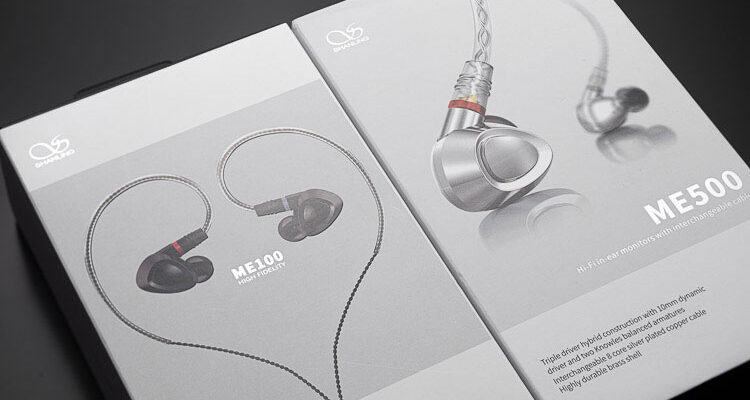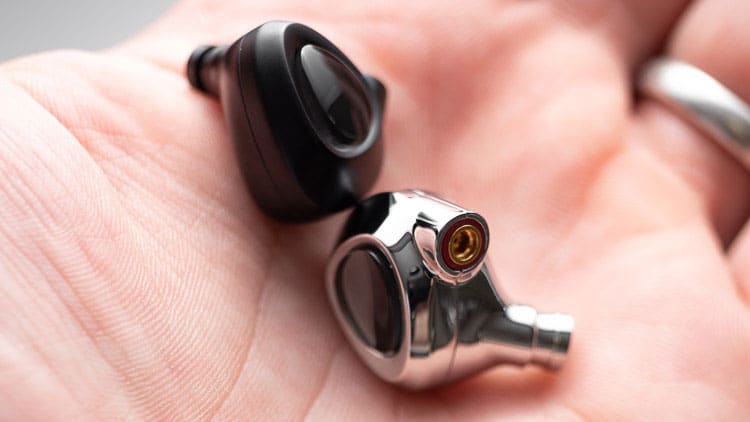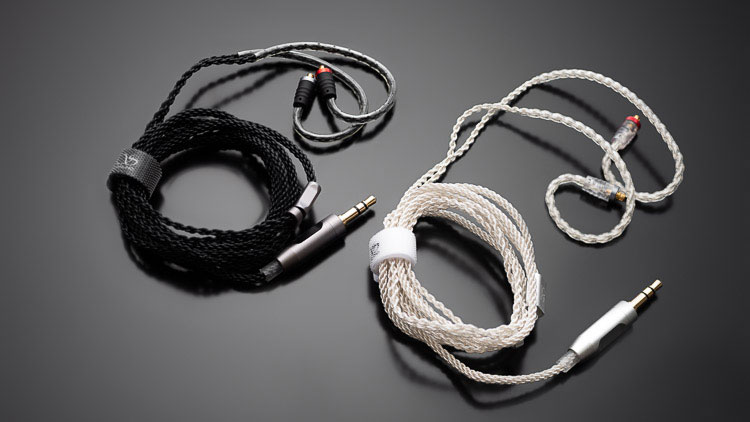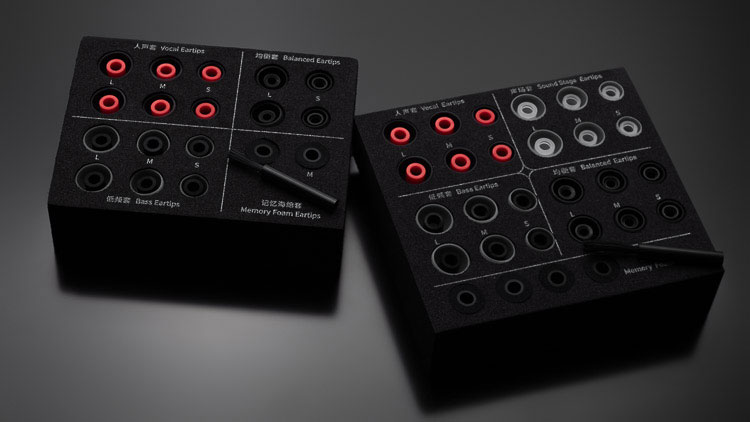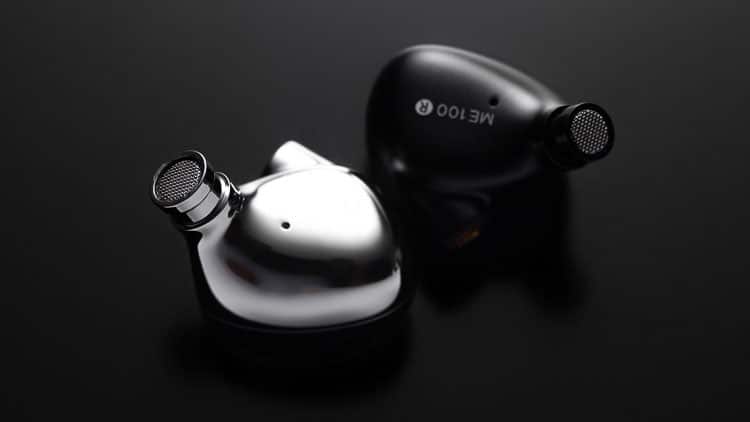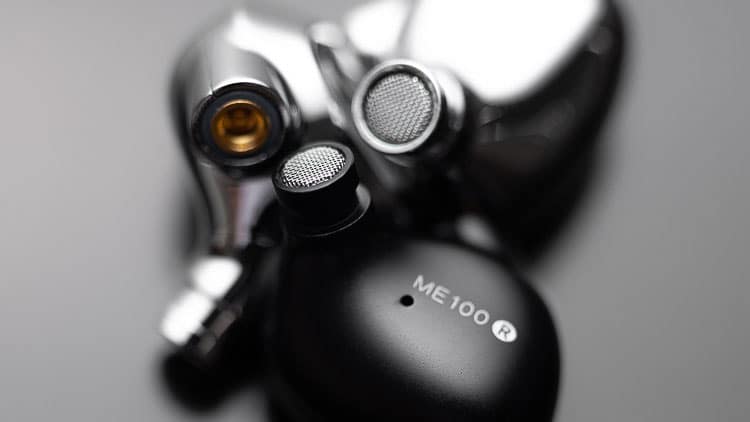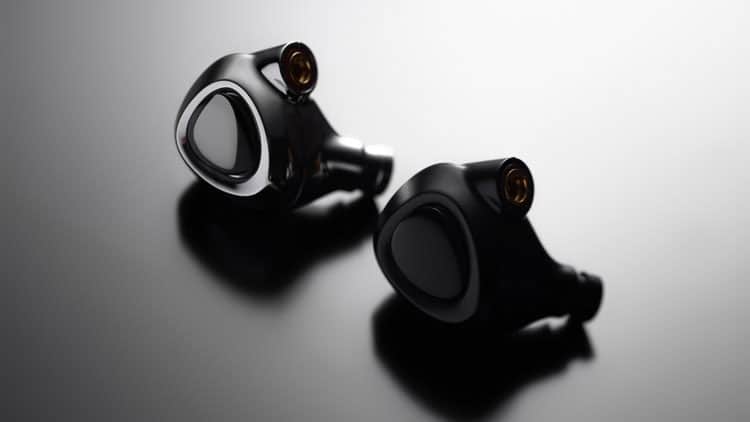The Shanling ME500 & ME100 are the first in a range of universal monitors featuring a hybrid triple driver and a single dynamic driver design. They are priced at $269 & $119 respectively.
Disclaimer: The Shanling ME500 & ME100 sent to us are samples in exchange for our honest opinion. We thank the team at Shanling for giving us this opportunity.
To read more about Shanling products we have reviewed on Headfonics click here.
Note, this 2-page review follows our new scoring guidelines for 2020 which you can read up on here.
My first experience with Shanling was the M2X. Both within and without the Shanling catalog, that little bugger was and is a tremendous product. It nailed branding. It nailed build. It mostly nailed UI. And, seeing my explicit love affair with it isn’t over, it nailed me. Ergo, what I expect today from Shanling is nothing less than spectacular. Against most vectors both the ME100 and ME500 deliver.
Build quality
It’s actually more of a surprise today to find earphones made of plastic. Color me not surprised that the ME100 is aluminum- or that the ME500 is chrome. Both have been designed straight for the universal market.
Each is solid, compact, and really well finished. The only blemishes I found – a single nipple on the rubber above the MMCX plug – should be expected at this price point and, in a perfect world, should disappear somewhere around 300$.
Both earphones’ cables stretch slightly. But they also nicely deke out the worst touch and other microphonic noises. The plug may be straight, but it is perfectly finished, perfectly bound together, and it even sports a sturdy stress relief.
Each cable is composed of twisted wire bundles. They’re not ugly but their branding is tough to suss. Like, how is it that the y-split is so similarly shaped like a Sony NW-WM1Z? Amazingly, the microscopic neck cinch not only is machined like a Leica, but it also holds the cable in place perfectly.
Comfort & Fit
The ME100 and ME500 fit pretty much the same. Sure, because the ME500 is like double the ME100’s weight, in the ear feel is different. Honestly, I dig the solid, heavy feel of ME500 brass, but the ME100’s aluminum keeps the same shape, but sheds the weight.
But both are comfortable, secure, and generally, follow the ear’s natural contours. Each bears a conservative ~125º entry angle, which adapts to both lazy and tight canals. Better still, the sound tube heads gently up into the ear rather than sprouting out at a perpendicular angle to the earphone’s flanks. This is a nice touch that, outside of custom earphones and Ultrasone’s IQ, is rarely seen.
The short of this is that, among over-ear cable earphones, the ME100 and ME500 are easily the most comfortable earphones I’ve reviewed at Headfonics and some of the most comfortable I’ve ever written about or fiddled with, anywhere. And, against everyone, including BGVP, they feel and look premium, at their price points and above.
Bonus: because they aren’t custom-cum universal (CCU) designs, they are nice and compact and sport a look and style unique to them.
Accessories
The ME100 comes with nine pairs of ear tips, including foam. There’s also a loop-less wax/cleaning tool. The ME500 adds another five sets of ear tips.
A glance at Shangling’s website shows that perhaps earlier ME500s came with turned aluminum cases. Mine didn’t. If you’re clever at origami, you’ll be able to pack it all into the included faux-leather case, but only barely. That case is generic, and not terribly utilitarian.
Do I want to put my ME100 in it when going out without a backpack? No. If I do, where will I put it? It won’t fit in my pocket. And I don’t often carry purses. How’s about holding it in my hand? Heck no. Throw it in with a bunch of other thoughtless carry case designs out there. Shame.
The ME500 aren’t much better. It opens like a toilet. Where the ME100 pushes out sharp corners, the ME500s are rounded. It’s also a bit less roomy inside. And, it also lacks holding mesh, meaning you’ll have to just pack everything in, haphazard-like.
Where is a compact zipper pouch when you need one? At the shop, that’s where. No manufacturer uses them. They all make the same unwieldy case that’s not that much better at protecting the earphone, and for what? Looks? Bosh. They all look like balls. When I go out with either earphone I go out with a cheap zipper pad I bought from Chapters in 2004.
Sound Impressions
Summary
The ME100 is bright, pretty damn neutral, with a decent stage feel and midrange presence. It’s not the sort of sound I expected from an earphone with a 10mm dynamic driver inside. I was ready for the weight. Next to my favorite 10mm dynamic driver earphone (the MDR-EX1000), it is downright bright.
Generally, it keeps things bright, top to bottom.
Despite added balanced armature TWFK drivers, the ME500 sounds more balanced, and even warmer through the mid and high ranges. Largely it keeps transition zones smooth. And, while not as wide and engulfing as the ME100’s, its stage even better bifurcates instruments from their surrounds. To me, it is the easier to listen to earphone. If only because the gulf in temperature between lows and mids/highs is narrower.
Staging
ME100
The ME100’s stage is pretty flat on the Y-axis, and it goes pretty far on the X-axis. Perhaps because of its large driver, it also details a decent step forward along the Z-axis. For the dosh, it really throws a powerful stereo image, full of great midrange and decent high-range stereo detail.
Bass stereo spread isn’t nearly as nuanced and tends to puddle in the middle. It is still decent though, with good texture rendering as low as it goes. Instrument separation is as good as a nice TWFK can, many of which tend to throw midrange details wide around the head. This places you way in the center of everything.
In contrast, the ME100 places you in the middle of it all but shrinks you to the size of an ant, and the action swarms overhead. If you’re into stereo detail and 3D nuances, this puppy will do you- just not as much in the bass.
ME500
The ME500 trumps the ME100 in a number of stage-related areas. One: because it doesn’t sound as flat wide along the X-axis, attention is pulled into the center. Two, soft gradients to the left and the right really magnify Z-axis nuance. Three, all of that pulls more attention to the Y-axis, which, while not taller than the ME100’s, sucks in more attention.
And all of that really pushes you into the music even more than through the ME100. Instead of wide and deep rivers rushing over you as in the ME100, the ME500 puts you in the river of sound. And you’re no longer an ant. You’re a human of natural proportions. Instruments recover super quick, and fading gradient edges force you to focus at the center and just to the left and the right where distinct instruments spring up and down and all around you.
If you want things wide, check out the ME100; if you want things layered, check out the ME500.
Bass
ME100
The ME100’s bass is among the most textured and deep I’ve heard in a neutral-leaning earphone. It has not got a lot of force behind either its forward or trailing edges, but it holds onto fades with warm decay the likes of which I’ve not heard since the Hidisz MS4. That said, it has nothing of the force or warmth of that earphone. But gosh, the warmth it does paint in is wonderful.
The balance between that warmth and the generally cool nature to ME100 mids and highs is interesting. Any warmer and it would really sound like a little brother to the MS4. Because it doesn’t, it really is an amalgamation of the MS1 and MS4.
It rattles a good bit in the opening of Marcus Schulz’s MainStage, but only after about five seconds in when the real sub-bass rumbling has finished. Were it able to yawn open those seconds, the transition to a cool-ish midrange might jar. So, maybe the current presentation is a good thing.
ME500
Surprisingly, the ME500’s lows are brighter than the ME100’s. Because mids and highs are also snappy, the transition to and fro is smoother and less jarring than the ME100. For this reason, I really prefer the ME500 when listening to a wide variety of genres.
What I miss is the more, textured, and stereo rich ME100 low range that really does its own thing on its own. The ME500’s converged low to mid-range is easier to listen to over a longer period of time, and probably will jive better with a larger range of audiophile listeners.
The difference here isn’t quite as distinct as the difference between an Astell & Kern TKIE8 and Beyerdynamic’s Xelento, but it’s not far off. The ME100 is sparklier and more contrasty, with greater weight and emphasis down low and a bit more sparkle up top. The ME500 is more even Stephen when balancing bass to highs.
The ME500 also pushes lows out to the sides more than does the ME100. No, it doesn’t render more or better texture, but because of that spread, bass pushes less into or under the mids and highs, and the u-shaped sound signature is softer. It’s got more than a little of a BGVP DM7 thing going on- which is good but won’t fulfill all the desires of the bass head.
Mids and highs
ME100
The ME100’s mildly warm bass sits apposed to a cool-ish midrange. Contrast between the two is best revealed by a frequency-separated space. Midrange stereo details are wide, pretty deep, and decently tall, whereas low frequencies congeal more toward the center.
This also helps to create the impression of a wide-set if not bright midrange. Vocals have sharp leading edges with quick fall off and short decays and all instruments – voice included – ring full whilst decking out environmental reverb. Part of this may be due to the earphone’s solid metal chassis and acoustic chambers. Part of it may just be a freaking amazing driver.
Highs extend well, deke out sibilance, and probably hit notable soft rings the way mild treble-heads dig. The bump up into treble from mids builds slowly and smoothly. It’s also got less stereo focus than mids, so its sound pressure rise over mids feels about as mild as can be. While definitely a rise above mids, this high range is just smooth enough that it might be a great introduction to the tentative treble head.
ME500
If the ME100’s midrange is slightly depressed or lacks bite in the vocals, the ME500 largely evens out that gulf. High-T male vocals don’t grip as much as they do in the lower-voiced ME100, but males with normal levels of testosterone – and even the voices of their gamma male counterparts – stick out well and with good grip. Female vocals also bump a bit more to the fore and slide silkily into the highs.
A swirly, ethereal transition from mids to highs can blur percussion fringes, but not enough to sound or feel hot. In general, the added midrange body pushes mids into starker focus. Whether you like or dislike this likely will depend on how much of a mid or high head you are.
Largely, midrange timbre is mid-bright. This extends all the way into fading high hats. It’s a governed energetic approach that should also keep treble heads happy, but won’t tread far outside the bounds of ‘normal’. And, the treble head portion of me insists you try it. It’s great.
Matchability
Both the ME100 and ME500 get pretty loud, and quick, but neither is as crazy hissy or sensitive as something like the Hidizs MS4 or even the BGVP DM7. This means that both earphones are better to pair with Sony Hi-MD and MD units, Fii0’s M6, and the like. It also means that it will pair better with some desktop systems.
Of course, neither is a Planar design; as a result, both will hiss. For reference, it hisses a bit less than the Audio Technica CK10. I wish it hissed less. All players today are powerful enough to output good volume with great current and most are able to sustain wild impedance swings. Why do earphone makers still develop earphones best suited to old sources with weak amps.
Select comparisons
Hidizs MS4
Really, the MS4’s warm bass is like the ME100’s turned up by a factor of two. It rumbles super low and hears things down there that most earphones can’t. But it is warmer, and more veiled across the mids than the ME100, and its highs sound almost depressed if the music you’re listening to is mastered for soft highs.
The balance within its audible bounds cants a bit too dark generally, but it is bloody addictive. The ME100 would be another 15% better if its bright, stereo-extended mids were a bit darker than they are. A baby MS4 is something I can only dream of. And the flatter ME500 is right bright next to the MS4. Despite this, it is as easy to listen to because of brilliant transitions from mids to highs. Of course, the basic tenor of both earphones is opposed.
Hidizs MS1
What Hidizs tried with the MS1 is laudable, if sometimes hard on the ear. It is too neutral and too wide. Or maybe it is the right amount of either, but the combination of both in one package is a bit jarring.
The ME100 is an easier listen and carries forward seeds of the MS4 whilst also spreading some of that bright/wide MS1 midrange around. I prefer the ME100. The ME500 has a smoother basic curve to the MS1 and is a brilliant counterpoint to the demerits of the MS1.
BGVP DM7
The DM7 is better balanced against the ME100 but also lacks as much beautiful, textured bass. In a sense, it is a good analog for the ME500 in other terms. It has a more spacious mid-range, but is comparable in lows and in many ways, in highs. Of course, the ME500 fits better and feels and looks higher-end thanks to a shape and fit unique to the ME100 and ME500.
Our Verdict
Both the ME100 and ME500 really shine at their respective prices. More than that, they shine among Chi-Fi earphones I’ve tested at Headfonics. They look, and feel, unique, and come with quality accessories. As always, Shanling’s branding is on pitch. The only thing I wonder about is the shape of the neck cinch.
No, I don’t like the fake leather pouches each comes with. They are as pointless as they are ubiquitous. Just as some people like the Star Wars sequels, people out there will and do like such pouches. I don’t pretend to get either, but it is what it is.
Anyway, both earphones inspire confidence in a fast-maturing and ramified Chi-Fi market. I don’t for a moment think you can outdo in quality what Shanling has done. This company knows its stuff and is forging ahead faster than the market in general. It is creating truly great products. I’m not sure which I prefer. The ME500 has the stabler sound signature, but the ME100’s bass line is more of my style.
Choosing between the two may be difficult but having that choice is great.
ME100 Specifications
- Driver: 10mm
- Plug: 3,5mm gold plated
- Cable length: 1,3m
- Wire: oxygen-free copper
- Impedance: 16Ω
- Sensitivity: ~111 dB
- Frequency response: 20 – 40.000Hz
- Weight: 26g (combined both sides and cable)
ME500 Specifications
- Driver: 10mm + Dual diaphragm armature
- Plug: 3,5mm gold plated
- Cable length: 1,3m
- Wire: Silver-played OFC + OFC
- Impedance: 18Ω
- Sensitivity: ~111 dB
- Frequency response: 20 – 40.000Hz
- Weight: 12.5g (per side)

